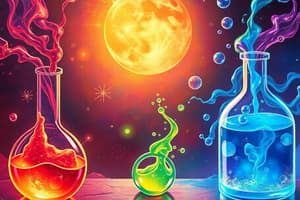Podcast
Questions and Answers
Which of the following is a characteristic property of acids?
Which of the following is a characteristic property of acids?
- Soapy texture
- Sour taste (correct)
- Bitter taste
- Slippery feel
All alkalis have a bitter taste.
All alkalis have a bitter taste.
False (B)
Name three acids commonly used in the laboratory.
Name three acids commonly used in the laboratory.
Hydrochloric acid, sulfuric acid, nitric acid
__________ is an alkali commonly known as lime water.
__________ is an alkali commonly known as lime water.
Match the following actions to the correct emergency procedure when acids or alkalis splash onto:
Match the following actions to the correct emergency procedure when acids or alkalis splash onto:
What should you do first if acids or alkalis splash into your eyes in the laboratory?
What should you do first if acids or alkalis splash into your eyes in the laboratory?
Litmus paper can be used to measure the exact pH value of a substance.
Litmus paper can be used to measure the exact pH value of a substance.
What colors do blue litmus paper and red litmus paper turn in an acidic solution, respectively?
What colors do blue litmus paper and red litmus paper turn in an acidic solution, respectively?
Substances with a pH value _______ than 7 are considered alkaline.
Substances with a pH value _______ than 7 are considered alkaline.
What happens during neutralization?
What happens during neutralization?
Thermal energy is absorbed during neutralization.
Thermal energy is absorbed during neutralization.
What are the products of a neutralization reaction?
What are the products of a neutralization reaction?
The first part of a salt's name comes from the _________ used in neutralization.
The first part of a salt's name comes from the _________ used in neutralization.
Which application involves neutralizing excess acid in the stomach?
Which application involves neutralizing excess acid in the stomach?
Dilute acids do not react with metals.
Dilute acids do not react with metals.
What gas is produced when dilute acids react with some metals?
What gas is produced when dilute acids react with some metals?
Materials containing __________ such as marble can be corroded by dilute acids.
Materials containing __________ such as marble can be corroded by dilute acids.
What is produced when dilute acids react with calcium carbonate?
What is produced when dilute acids react with calcium carbonate?
Rainwater is always acidic.
Rainwater is always acidic.
Name two acidic gases released by burning fossil fuels that contribute to acid rain.
Name two acidic gases released by burning fossil fuels that contribute to acid rain.
Flashcards
Acids
Acids
Substances with a sour taste.
Alkalis
Alkalis
Substances that feel slippery.
Common lab acids
Common lab acids
Hydrochloric, sulphuric, and nitric acid
Common lab Alkalis
Common lab Alkalis
Signup and view all the flashcards
Lab safety with acids/alkalis
Lab safety with acids/alkalis
Signup and view all the flashcards
Acid/alkali on skin
Acid/alkali on skin
Signup and view all the flashcards
Acid/alkali in eyes
Acid/alkali in eyes
Signup and view all the flashcards
Acid/alkali on clothes
Acid/alkali on clothes
Signup and view all the flashcards
Uses of acids
Uses of acids
Signup and view all the flashcards
Uses of alkalis
Uses of alkalis
Signup and view all the flashcards
Pigments
Pigments
Signup and view all the flashcards
Litmus
Litmus
Signup and view all the flashcards
pH scale
pH scale
Signup and view all the flashcards
Acidic pH
Acidic pH
Signup and view all the flashcards
Neutral pH
Neutral pH
Signup and view all the flashcards
Alkaline pH
Alkaline pH
Signup and view all the flashcards
Alkali effect on pH
Alkali effect on pH
Signup and view all the flashcards
Neutralization equation
Neutralization equation
Signup and view all the flashcards
Dilute acids
Dilute acids
Signup and view all the flashcards
Acid rain gases
Acid rain gases
Signup and view all the flashcards
Study Notes
Common Acids and Alkalis
- Acids taste sour.
- Alkalis feel slippery; some have a bitter taste.
- Many foods, drinks, and household products contain acids.
- Some foods and household products contain alkalis.
- Hydrochloric, sulphuric, and nitric acids are commonly used in the laboratory.
- Sodium hydroxide, ammonia solution, and calcium hydroxide (lime water) are alkalis commonly used in the laboratory.
- Acids and alkalis can be irritant or corrosive, so handle with care and safety precautions.
Safety Precautions
- Read hazard warning symbols on chemical bottles to identify risks.
- Wear a lab coat, disposable or protective gloves, and safety spectacles.
- Do not mix acids or alkalis with other chemicals without teacher approval.
- Pour waste solutions into suitable waste bottles, not the sink.
- Wash hands thoroughly after handling acids or alkalis.
Emergency Treatments
- In accidents in the lab, remain calm and report to the teacher.
- If acids or alkalis splash on skin, immediately wash the area under slow-running water for at least 10 minutes.
- If in eyes, immediately wash the affected eye(s) using an eyewash bottle for at least 10 minutes.
- If on clothes, carefully remove them, avoiding further contact.
Uses of Acids and Alkalis
- Acids are used for food preservation and stain removal.
- Alkalis are used for making noodles and grease removal.
Distinguishing Acids and Alkalis
- Some plants contain pigments that change color in acidic or alkaline solutions, acting as acid-alkali indicators.
- Litmus is a common acid-alkali indicator with blue and red forms.
- Litmus is available in solution or as litmus paper.
Litmus Paper Color Changes
- Blue litmus turns red in acidic solutions, remains blue in neutral and alkaline solutions.
- Red litmus turns blue in alkaline solutions, remains red in acidic and neutral solutions.
pH Scale
- pH scale describes the acidity or alkalinity of a substance.
- Acidic substances have a pH lower than 7.
- Neutral substances have a pH of 7.
- Alkaline substances have a pH higher than 7.
- Universal indicator and pH paper are used to measure pH values.
- A pH meter is an electronic instrument for measuring pH values.
Universal Indicator vs pH Meter
- Universal indicator is convenient (no calibration needed) using less solution
- Universal indicator is not suitable for dark-colored solutions, cannot be reused and has subjective results
- pH meter works for any solution, can be reused and provides small reading error.
- pH meter needs calibration and more solution.
Neutralization
- Adding an alkali to an acid increases the pH; adding an acid to an alkali decreases the pH.
- When pH reaches 7, the solution is neutral, and the acid and alkali neutralize each other.
- Neutralization forms salt and water, releasing thermal energy.
- The general equation for neutralization is: acid + alkali -> salt + water.
- The type of salt formed depends on the acid and alkali used.
Steps in Writing Neutralization Equations
- Write down the reactants.
- The salt name has two parts: the first from the alkali, the second from the acid.
- Add "water" as the other product.
- Reactants and products mass is conserved during neutralization.
Applications of Neutralization
- Antacids (alkaline) neutralize excess stomach acid to relieve pain.
- Toothpaste (slightly alkaline) neutralizes mouth acids to prevent tooth decay.
- Chemical waste (acids or alkalis) is neutralized before discharge.
- Soap solutions (alkali) neutralize acidic bee/mosquito/ant stings.
- Vinegar (acid) helps neutralize alkaline wasp stings.
- Alkaline lime is added to acidic soil to raise pH.
- Sulphur converted to sulphuric acid lowers the soil pH.
Corrosive Nature of Acids
- Dilute acids react with some metals to produce hydrogen, corroding the metal.
- General equation: metal + acid -> salt + hydrogen.
- The type of salt produced depends on the acid and metal:
- zinc + hydrochloric acid -> zinc chloride + hydrogen
- calcium + sulphuric acid -> calcium sulphate + hydrogen
- Dilute acids corrode building materials containing calcium carbonate like marble/limestone.
- Dilute acids reacting with calcium carbonate produce carbon dioxide.
- General equation: carbonate + acid -> salt + water + carbon dioxide.
- Salt type depends on the acid and carbonate:
- calcium carbonate + hydrochloric acid -> calcium chloride + water + carbon dioxide
- magnesium + sulphuric acid -> magnesium sulphate + water + carbon dioxide
Acid Rain
- Natural rainwater pH is about 5.6; below 5.6 is acid rain.
- Burning fossil fuels releases sulphur dioxide and nitrogen oxides.
- Acidic gases react with oxygen and water, increasing rainwater acidity.
Effects of Acid Rain
- Acid rain damages plant leaves, reducing photosynthesis.
- Toxic minerals released into soil harm plant growth.
- Acid rain washes toxic minerals into water bodies, killing aquatic life.
- Acid rain corrodes buildings/statues with calcium carbonate.
- Acid rain corrodes metal objects.
Hazards of Acids and Alkalis
- Concentrated acids and alkalis are highly corrosive, handle with extra care.
- Mixing cleansing products can be dangerous, releasing toxic substances and thermal energy.
Safety Rules for Cleansing Products
- Keep the room well-ventilated.
- Wear gloves, a mask, and protective clothing.
- Wash hands thoroughly after use.
- After an accident, remain calm and provide proper treatment.
- If splashed on the body, wash with a lot of slow-running water.
- If a harmful gas is inhaled, open windows and move the injured person to fresh air.
- If the injury is serious, take the injured person to a hospital ASAP.
Studying That Suits You
Use AI to generate personalized quizzes and flashcards to suit your learning preferences.




